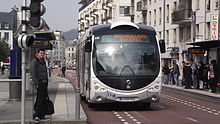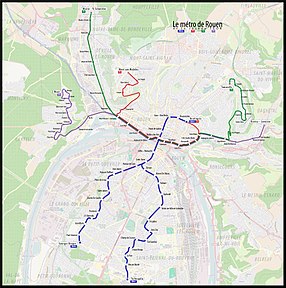Tramway Rouen
| Tramway Rouen | |
|---|---|
| Basic information | |
| Country | France |
| city | Rouen |
| opening | 1994 |
| operator | TCAR |
| Infrastructure | |
| Route length | 15.1 km |
| Gauge | 1435 mm ( standard gauge ) |
| Power system | 750 V DC overhead line |
| Stops | 31 |
| Tunnel stations | 5 |
| business | |
| Lines | 2 |
| vehicles | 27 Alstom Citadis 402 |
| statistics | |
| Passengers | 67,000 per day (2010) |
| Tram (blue) and TEOR bus network | |
The tram Rouen ( French: Tramway de Rouen ) is a tram in the French city of Rouen . Between the two world wars, it was one of the most extensive networks in all of France . After the shutdown in 1953, after a break of around 40 years, a new network was put into operation in 1994. The operating company is Transports en commun de l'agglomération rouennaise (TCAR), a subsidiary of Veolia .
History of the historic tram

The first tram line in Rouen was built after the Franco-Prussian War of 1870/71 and put into operation on December 29, 1877 over a length of 27 km. A brief attempt at steam operation was ended as early as 1884 and they returned to the horse-drawn tram . As early as 1895, the entire route network was electrified in view of the planned colonial exhibition of 1896 in Rouen.
To overcome the relatively large difference in altitude between the valley of the Seine and the heights to the south of it, the village of Bonsecours was connected to Rouen with a funicular in 1892 and was supplemented by a tram in 1899 and replaced a little later. The last route extensions were made in 1912 with an overland route to Bois-Guillaume and in 1915 with the connection of a barracks to public transport . The network comprises 19 lines.
After the first bus line went into operation in 1927 , the tram finally had to give way. In 1930 operations on the first line were stopped.
After a certain decline between the First World War and the Second World War , the end of the Second World War brought a sobering balance sheet. Of the 78 railcars that were available in 1939, only 38 were still operational. There was also major damage to the tracks and overhead lines . The depot was also damaged several times by bombs . In addition, all bridges over the Seine had been destroyed, dividing the network in two.
In 1950, the city administration decided that tram operations should be stopped in the medium term, which finally took place in February 1953.
History of the modern tram


In 1982 the regional authority Syndicat intercommunal à vocation multiple (Sivom) determined that road traffic threatened to suffocate the city. The inadequacy of municipal bus transport, which was considered insufficient, irregular and slow, is one of the causes of the traffic jams. Nevertheless, it was four years before the city and municipal councils of the metropolitan area commissioned the Center d'études technique et de l'équipement (Cété) with a corresponding study. In May 1987 the Cété determined that a VAL system was too expensive, whereas a tram would correspond to the geographic conditions of the city and the needs of its residents. Under Mayor Jean Lecanuet ( UDF ), the preliminary draft for a light rail ("Métro léger") was commissioned in September 1978, which envisaged the construction of two 10.3 km long lines at a cost of 1.6 billion francs . After Laurent Fabius ( PS ) from Lecanuet took over the chairmanship of the Sivom in March 1989 , the project was revised in favor of a Y-shaped, 11.2 km long route.
On February 28, 1991, the Sivom made the decision to build a 10.7 km long light rail line with a 1850 m long tunnel section . Construction work began that same year, the tunnel under the city center was built using the shield driving method . The cost was estimated at 320 million euros. On December 16, 1994, the new lift went into operation. On September 1, 1997, the route was extended to Saint-Étienne-du-Rouvray to the new Technopôle terminus and the Palais de Justice station in the city center was opened. In 2011/2012 the terminus Technopôle and Boulingrin as well as the Saint-Sever station and the overpass over the Seine (Pont Jeanne d'Arc) were rebuilt.
With the metro buses TEOR (= Transport est-ouest rouennais), a tram advance system was to be created, but the planned expansion as a tram was abandoned in 1997 for reasons of cost. About 50% of the TEOR buses on lines T1, T2 and T3 run on their own route with optical lane guidance . The Boulingrin stop is the common endpoint of the tram and the T1 line, the central connection point is the Théâtre des Arts station .
Metro or tram?
Since a small part of the route runs in the tunnel and some stops are also there, the train is classified as an underground (Métro) in France , although the vehicles used are typical tram cars. As is customary with trams, power is supplied via an overhead line .
In the city of Rouen, the tram is called Métro léger (light subway) and has received the line designation "M" (like Métro).
route
The route resembles an inverted Y and connects five municipalities: Rouen, Le Petit-Quevilly , Le Grand-Quevilly , Sotteville-lès-Rouen and Saint-Étienne-du-Rouvray . The northern part runs in a tunnel through the city center of Rouen with four underground stations: Beauvoisine, Gare-Rue Verte, Palais de Justice and Théâtre des Arts. The Saint Severs stop is already south of the Seine, which is crossed on a pre-existing bridge. Then the route divides into two branches: the eastern one leads to the Technopôle du Madrillet in Saint-Étienne-du-Rouvray, the western one connects Le Grand-Quevilly with Rouen.
To the south of the Seine, the route essentially runs on the surface. Only three important road crossings are driven under and only the Joffre-Mutualité stop is in the tunnel.
Of the 15 km route, only 2.2 km run underground. Of the total of 31 stops, five are in the tunnel. Their length is 60 m each. The design of the stations on the surface - on both sides with 12 m long covered waiting areas, with monitors for timetable information and ticket machines - is a design by the French architect Jean-Michel Wilmotte , who was involved in the renovation of the Louvre and the Elysee Palace in Paris has contributed. The track is equipped with a 750 V direct current contact line. The 35,000 m² depot is located near Charles de Gaulle station in Le Grand-Quevilly .
Timetable and travel times
From Boulingrin, the trains go south at different intervals depending on the time of day. Sometimes there are less than 10 minutes between two trips in the same direction. As a result, the trains follow each other in the northern part of the route every five minutes.
The first trips start in the morning around 5 a.m., the last trains of the day leave shortly before 11 p.m. A journey from terminus to terminus takes 30 minutes on the Boulingrin - Technopole route or 25 minutes on the Boulingrin - Le Grand Quvilly-Georges Braque route.
vehicles

27 Alstom Citadis trams are used , which are 42 m long and can hold up to 300 people.
At its meeting on February 28, 1991, the Sivom had decided to purchase vehicles of the partially low-floor type Tramway français standard (TFS), although it would have preferred completely low-floor trams. However, only the manufacturers Alsthom and Socimi responded to a tender in the spring of 1990, and their offers were 10% above the estimated budget of 272 million francs.
So by 2013, 28 Alsthom TFS trams were in use. The first test drives took place from the end of 1993. The three-part bidirectional sets were 29 m long, the low-floor area was almost 18 m. In ten years the number of passengers has increased by 60%, which has led to enormous capacity problems during rush hour . On January 1, 2010 it was therefore decided to order 27 new Alstom Citadis for a value of 90 million euros. The TFS were sold to Gaziantep .
literature
- Jean Tricoire: Le tramway en France . La Vie du Rail, 2007, ISBN 978-2-915034-73-8 .
- Charles Crespolini, Pascal Godon: m-é-trobus. A métro léger for the agglomeration of rouennaise . La Vie du Rail, 1995, ISBN 2-902808-55-0 .
Web links
Individual evidence
- ↑ a b c d e f g h i j k Jean Tricoire: Le tramway en France . La Vie du Rail, Paris 2007, ISBN 978-2-915034-73-8 , p. 119-123 .
- ↑ a b Rouen se met dans les roues de Grenoble in: La Vie du Rail 2266/1991, p. 17 f.
- ↑ Stadtverkehr Aktuell in: Stadtverkehr 7/1991, p. 50.
- ↑ La rame Citadis d'Alstom choisi pour renouveler le métro de l'agglomeration de Rouen on drakkaronline.com




